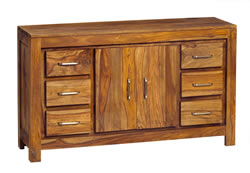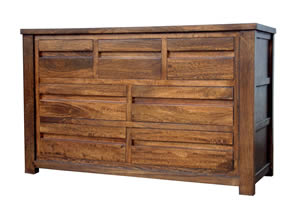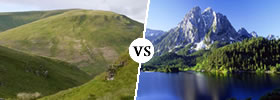Difference between Sheesham and Mango Wood
Key difference: Sheesham is essentially a type of rosewood. It is sourced from the Dalbergia sissoo species of trees which is more commonly known as Indian Rosewood. It is commonly used for making furniture, especially cabinets. This is mainly due to the fact that the wood is highly durable and long lasting. Mango wood, on the other hand, is the wood of the mango trees. These trees belong to the Mangifera genus. Mango wood is a tropical hardwood from an evergreen tree. As a wood, mango is moderately hard and dense. Its strongest feature is the fact that it is highly water-resistant. Mango wood has a unique grain as it incorporates many different colors and tones. Mango wood is most commonly used to make furniture, as well as turning pieces, such as vases and bowls.
 Sheesham is essentially a type of rosewood. Rosewood refers to the wood of different trees, including trees from the Tipuana, Pterocarpus and Dalbergia genera of trees. These genera contain various types of tropical or subtropical leguminous trees that are most commonly found in Central and South America, Africa, Madagascar and southern Asia.
Sheesham is essentially a type of rosewood. Rosewood refers to the wood of different trees, including trees from the Tipuana, Pterocarpus and Dalbergia genera of trees. These genera contain various types of tropical or subtropical leguminous trees that are most commonly found in Central and South America, Africa, Madagascar and southern Asia.
Sheesham is sourced from the Dalbergia sissoo species of trees which is more commonly known as Indian Rosewood. The tree is native to the Indian Subcontinent and Southern Iran. Regionally, the wood is referred to as sheesham, sisu, tahli, Tali, Irugudujava or jag. Sheesham is essentially a hardwood. Hardwood is basically the wood that comes from an angiosperm tree. This is a type of tree that has seeds that are enclosed, be it in pods, a shell, a covering or in a fruit. For example, apples or nuts and seeds like acorns and walnuts. These types of seeds allow birds and insects to be attracted to the flowers of the tree and be able to carry the pollen to other trees. This is also the reason why hardwood trees are not often bunched together but are spaced apart and often have other trees in-between them.
Most hardwood trees are also deciduous is nature. A deciduous tree is a tree that loses its leaves annually. Hardwood trees are also slower to grow, taking their own time. Due to this, most hardwood is dense. This is also the reason that hardwood is expensive, as it takes longer to grow. Some famous hardwoods include maple, balsa, oak, elm, mahogany, and sycamore.
Sheesham or Shisham has become famous internationally as a premier timber species of rosewood. It is commonly used for making furniture, especially cabinets. This is mainly due to the fact that the wood is highly durable and long lasting. It is in fact decay resistant. The heartwood is extremely durable and is very resistant to dry-wood termites; however, a disadvantage of sheesham is that the sapwood is prone to woodboring beetles. Hence, the owner must ensure that the furniture is free of the beetles or its eggs and that piece of furniture is well maintained.
Sheesham is also used to make veneers and plywood. Additionally, it is also used to make musical instruments, specifically for percussion due to the resonance abilities of all rosewood. The Rajasthani percussion instrument, 'Kartaals' are often made of sheesham. Sheesham may also be used for flooring, agricultural tools, boatbuilding, carving, skis and turning objects. Furthermore, it is also commonly used as fuel and the tree is planted on roadsides, along canals and as a shade tree for tea plantations.
The heartwood of sheesham ranges from golden brown to a darker reddish brown, while the sapwood ranges from white to pale brownish white. Sheesham has a straight grain though it can be interlocked. The texture of Sheesham is medium to coarse with a good natural luster.
 Mango wood, on the other hand, is the wood of the mango trees. These trees belong to the Mangifera genus. The mango trees are native to South Asia. However the popularity of the mango as a fruit has led to the cultivation of the trees in many tropical and subtropical regions. The mango trees are long lived, however the trees stop producing fruit as it ages. Once the tree stops producing fruit, it is cut down and replaced. The felled tree, which would have gone to waste, is now popularly being used as timber. Hence, mango wood is being touted as being environment friendly.
Mango wood, on the other hand, is the wood of the mango trees. These trees belong to the Mangifera genus. The mango trees are native to South Asia. However the popularity of the mango as a fruit has led to the cultivation of the trees in many tropical and subtropical regions. The mango trees are long lived, however the trees stop producing fruit as it ages. Once the tree stops producing fruit, it is cut down and replaced. The felled tree, which would have gone to waste, is now popularly being used as timber. Hence, mango wood is being touted as being environment friendly.
Mango wood is a tropical hardwood from an evergreen tree. This means that while the mango trees are angiosperm in nature, they are not deciduous. An evergreen tree is a tree that which keeps its leaves all year round, as oppose to a deciduous tree, which loses most or all of its leaves once a year. Other types of evergreen hardwoods include Mahogany, Teak, African Walnut, Iroko, Afrormosia and Balsa.
As a wood, mango is moderately hard and dense. Its strongest feature is the fact that it is highly water-resistant. Mango wood has a unique grain as it incorporates many different colors and tones. It often ranges from light tan to dark brown and may have hints of pink, light green and/or dark green. Due to this, mango wood looks good in its natural form and does not require much finishing. The wood does however usually have a coat or two of polish to protect it and make even more durable.
Mango wood is most commonly used to make furniture, as well as turning pieces, such as vases and bowls. However, a disadvantage of mango wood is that the sapwood of mango trees is susceptible to fungi. Still, the presence of fungi may lead the tree to take an attractive black coloring in the wood’s grain pattern. This adds character to the wood, which may be treated for fungus before being processed as timber.
Image Courtesy: true-furniture.co.uk, richardjamesinteriors.co.uk









Add new comment